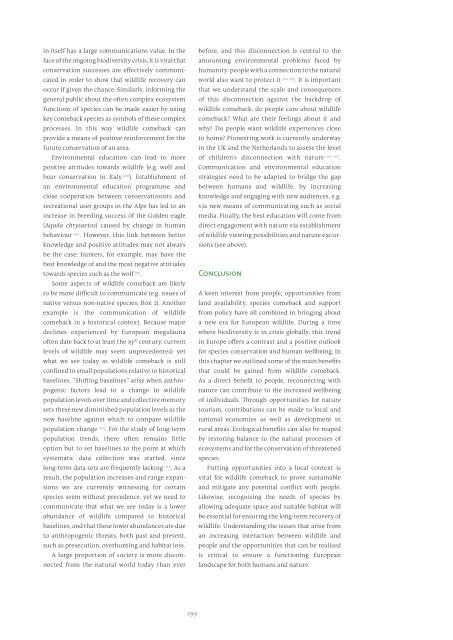130925-studie-wildlife-comeback-in-europe
Create successful ePaper yourself
Turn your PDF publications into a flip-book with our unique Google optimized e-Paper software.
<strong>in</strong> itself has a large communications value. In the<br />
face of the ongo<strong>in</strong>g biodiversity crisis, it is vital that<br />
conservation successes are effectively communicated<br />
<strong>in</strong> order to show that <strong>wildlife</strong> recovery can<br />
occur if given the chance. Similarly, <strong>in</strong>form<strong>in</strong>g the<br />
general public about the often complex ecosystem<br />
functions of species can be made easier by us<strong>in</strong>g<br />
key <strong>comeback</strong> species as symbols of these complex<br />
processes. In this way <strong>wildlife</strong> <strong>comeback</strong> can<br />
provide a means of positive re<strong>in</strong>forcement for the<br />
future conservation of an area.<br />
Environmental education can lead to more<br />
positive attitudes towards <strong>wildlife</strong> (e.g. wolf and<br />
bear conservation <strong>in</strong> Italy [147] ). Establishment of<br />
an environmental education programme and<br />
close cooperation between conservationists and<br />
recreational user groups <strong>in</strong> the Alps has led to an<br />
<strong>in</strong>crease <strong>in</strong> breed<strong>in</strong>g success of the Golden eagle<br />
(Aquila chrysaetos) caused by change <strong>in</strong> human<br />
behaviour [161] . However, this l<strong>in</strong>k between better<br />
knowledge and positive attitudes may not always<br />
be the case: hunters, for example, may have the<br />
best knowledge of and the most negative attitudes<br />
towards species such as the wolf [151] .<br />
Some aspects of <strong>wildlife</strong> <strong>comeback</strong> are likely<br />
to be more difficult to communicate (e.g. issues of<br />
native versus non-native species; Box 2). Another<br />
example is the communication of <strong>wildlife</strong><br />
<strong>comeback</strong> <strong>in</strong> a historical context. Because major<br />
decl<strong>in</strong>es experienced by European megafauna<br />
often date back to at least the 19 th century, current<br />
levels of <strong>wildlife</strong> may seem unprecedented: yet<br />
what we see today as <strong>wildlife</strong> <strong>comeback</strong> is still<br />
conf<strong>in</strong>ed to small populations relative to historical<br />
basel<strong>in</strong>es. “Shift<strong>in</strong>g basel<strong>in</strong>es” arise when anthropogenic<br />
factors lead to a change <strong>in</strong> <strong>wildlife</strong><br />
population levels over time and collective memory<br />
sets these new dim<strong>in</strong>ished population levels as the<br />
new basel<strong>in</strong>e aga<strong>in</strong>st which to compare <strong>wildlife</strong><br />
population change [162] . For the study of long-term<br />
population trends, there often rema<strong>in</strong>s little<br />
option but to set basel<strong>in</strong>es to the po<strong>in</strong>t at which<br />
systematic data collection was started, s<strong>in</strong>ce<br />
long-term data sets are frequently lack<strong>in</strong>g [163] . As a<br />
result, the population <strong>in</strong>creases and range expansions<br />
we are currently witness<strong>in</strong>g for certa<strong>in</strong><br />
species seem without precedence, yet we need to<br />
communicate that what we see today is a lower<br />
abundance of <strong>wildlife</strong> compared to historical<br />
basel<strong>in</strong>es, and that these lower abundances are due<br />
to anthropogenic threats, both past and present,<br />
such as presecution, overhunt<strong>in</strong>g and habitat loss.<br />
A large proportion of society is more disconnected<br />
from the natural world today than ever<br />
before, and this disconnection is central to the<br />
amount<strong>in</strong>g environmental problems faced by<br />
humanity: people with a connection to the natural<br />
world also want to protect it [164, 165] . It is important<br />
that we understand the scale and consequences<br />
of this disconnection aga<strong>in</strong>st the backdrop of<br />
<strong>wildlife</strong> <strong>comeback</strong>: do people care about <strong>wildlife</strong><br />
<strong>comeback</strong>? What are their feel<strong>in</strong>gs about it and<br />
why? Do people want <strong>wildlife</strong> experiences close<br />
to home? Pioneer<strong>in</strong>g work is currently underway<br />
<strong>in</strong> the UK and the Netherlands to assess the level<br />
of children’s disconnection with nature [166, 167] .<br />
Communication and environmental education<br />
strategies need to be adapted to bridge the gap<br />
between humans and <strong>wildlife</strong>, by <strong>in</strong>creas<strong>in</strong>g<br />
knowledge and engag<strong>in</strong>g with new audiences, e.g.<br />
via new means of communicat<strong>in</strong>g such as social<br />
media. F<strong>in</strong>ally, the best education will come from<br />
direct engagement with nature via establishment<br />
of <strong>wildlife</strong> view<strong>in</strong>g possibilities and nature excursions<br />
(see above).<br />
Conclusion<br />
A keen <strong>in</strong>terest from people, opportunities from<br />
land availability, species <strong>comeback</strong> and support<br />
from policy have all comb<strong>in</strong>ed <strong>in</strong> br<strong>in</strong>g<strong>in</strong>g about<br />
a new era for European <strong>wildlife</strong>. Dur<strong>in</strong>g a time<br />
where biodiversity is <strong>in</strong> crisis globally, this trend<br />
<strong>in</strong> Europe offers a contrast and a positive outlook<br />
for species conservation and human wellbe<strong>in</strong>g. In<br />
this chapter we outl<strong>in</strong>ed some of the ma<strong>in</strong> benefits<br />
that could be ga<strong>in</strong>ed from <strong>wildlife</strong> <strong>comeback</strong>.<br />
As a direct benefit to people, reconnect<strong>in</strong>g with<br />
nature can contribute to the <strong>in</strong>creased wellbe<strong>in</strong>g<br />
of <strong>in</strong>dividuals. Through opportunities for nature<br />
tourism, contributions can be made to local and<br />
national economies as well as development <strong>in</strong><br />
rural areas. Ecological benefits can also be reaped<br />
by restor<strong>in</strong>g balance to the natural processes of<br />
ecosystems and for the conservation of threatened<br />
species.<br />
Putt<strong>in</strong>g opportunities <strong>in</strong>to a local context is<br />
vital for <strong>wildlife</strong> <strong>comeback</strong> to prove susta<strong>in</strong>able<br />
and mitigate any potential conflict with people.<br />
Likewise, recognis<strong>in</strong>g the needs of species by<br />
allow<strong>in</strong>g adequate space and suitable habitat will<br />
be essential for ensur<strong>in</strong>g the long-term recovery of<br />
<strong>wildlife</strong>. Understand<strong>in</strong>g the issues that arise from<br />
an <strong>in</strong>creas<strong>in</strong>g <strong>in</strong>teraction between <strong>wildlife</strong> and<br />
people and the opportunities that can be realised<br />
is critical to ensure a function<strong>in</strong>g European<br />
landscape for both humans and nature.<br />
299


